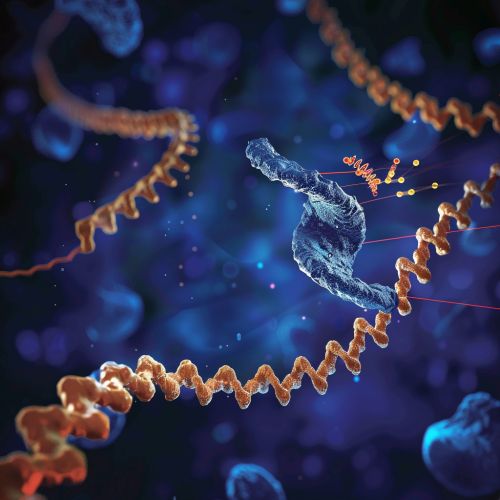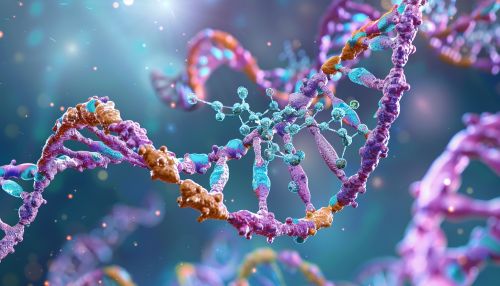Gene product: Difference between revisions
(Removed redirect to Gene Product) Tag: Removed redirect |
No edit summary |
||
| Line 3: | Line 3: | ||
A gene product is the biochemical material, either RNA or protein, resulting from the expression of a gene. The process of gene expression involves transcription of DNA into RNA, followed by translation of RNA into a protein. Gene products play crucial roles in cellular function, structure, and regulation. | A gene product is the biochemical material, either RNA or protein, resulting from the expression of a gene. The process of gene expression involves transcription of DNA into RNA, followed by translation of RNA into a protein. Gene products play crucial roles in cellular function, structure, and regulation. | ||
[[Image:Detail-92627.jpg|thumb|center|Illustration of gene expression showing DNA being transcribed into RNA and then translated into protein.|class=only_on_mobile]] | |||
[[Image:Detail-92628.jpg|thumb|center|Illustration of gene expression showing DNA being transcribed into RNA and then translated into protein.|class=only_on_desktop]] | |||
=== Gene Expression === | === Gene Expression === | ||
Latest revision as of 01:42, 19 June 2024
Gene Product
A gene product is the biochemical material, either RNA or protein, resulting from the expression of a gene. The process of gene expression involves transcription of DNA into RNA, followed by translation of RNA into a protein. Gene products play crucial roles in cellular function, structure, and regulation.


Gene Expression
Gene expression is the process by which information from a gene is used in the synthesis of a functional gene product. This process can be divided into two main stages: transcription and translation.
Transcription
Transcription is the first step in gene expression, where a particular segment of DNA is copied into RNA by the enzyme RNA polymerase. The resulting RNA molecule is a complementary copy of the DNA template strand. This RNA can be a messenger RNA (mRNA), transfer RNA (tRNA), or ribosomal RNA (rRNA), depending on the gene being expressed.
Translation
Translation is the process by which the sequence of a messenger RNA (mRNA) is decoded by a ribosome to produce a specific polypeptide or protein. During translation, the mRNA sequence is read in sets of three nucleotides, known as codons, each of which specifies a particular amino acid.
Types of Gene Products
Gene products can be broadly categorized into two types: RNA molecules and proteins.
RNA Molecules
RNA molecules are crucial for various cellular processes. The primary types of RNA molecules include:
- mRNA: Carries genetic information from DNA to the ribosome, where it serves as a template for protein synthesis.
- tRNA: Transfers specific amino acids to the ribosome during protein synthesis.
- rRNA: Forms the core of the ribosome's structure and catalyzes protein synthesis.
Proteins
Proteins are the most diverse and abundant gene products. They perform a wide range of functions, including:
- Enzymes: Catalyze biochemical reactions.
- Structural proteins: Provide support and shape to cells and tissues.
- Transport proteins: Carry molecules across cell membranes.
- Regulatory proteins: Control gene expression and coordinate cellular activities.
Regulation of Gene Expression
Gene expression is tightly regulated to ensure that the correct gene products are produced at the right time and in appropriate amounts. Regulation can occur at multiple levels, including:
- Transcriptional regulation: Control of the rate at which genes are transcribed into RNA.
- Post-transcriptional regulation: Modifications to RNA molecules after transcription, such as splicing and editing.
- Translational regulation: Control of the rate at which mRNA is translated into protein.
- Post-translational regulation: Modifications to proteins after translation, such as phosphorylation and ubiquitination.
Functional Roles of Gene Products
Gene products are essential for the proper functioning of cells and organisms. Some of their key roles include:
- Metabolic processes: Enzymes catalyze reactions that convert nutrients into energy and building blocks for growth.
- Cell signaling: Proteins and RNA molecules transmit signals within and between cells to coordinate activities.
- Gene regulation: Regulatory proteins and RNA molecules control the expression of other genes.
- Immune response: Proteins such as antibodies and cytokines play critical roles in defending against pathogens.
Techniques for Studying Gene Products
Several techniques are used to study gene products, including:
- Western blotting: Detects specific proteins in a sample using antibodies.
- Northern blotting: Detects specific RNA molecules in a sample.
- Polymerase chain reaction (PCR): Amplifies specific DNA or RNA sequences.
- Mass spectrometry: Identifies and quantifies proteins based on their mass and charge.
Applications of Gene Product Research
Research on gene products has numerous applications in medicine, biotechnology, and agriculture. Some notable applications include:
- Gene therapy: Treating genetic disorders by introducing, removing, or altering gene products.
- Biopharmaceuticals: Producing therapeutic proteins such as insulin and monoclonal antibodies.
- Genetically modified organisms (GMOs): Enhancing crop traits such as pest resistance and nutritional content.
